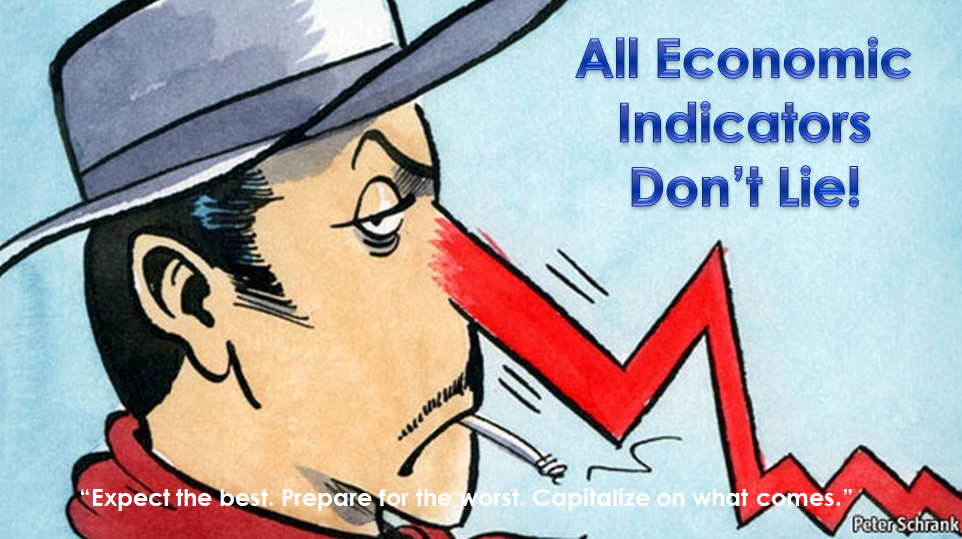IN-DEPTH: TRANSCRIPTION - LONGWave - 03-08-23 - MARCH – All Economic Indicators Don’t Lie!
SLIDE DECK
TRANSCRIPTION
SLIDE 2
Thank you for joining me. I'm Gord Long.
A REMINDER BEFORE WE BEGIN: DO NO NOT TRADE FROM ANY OF THESE SLIDES - they are COMMENTARY for educational and discussion purposes ONLY.
Always consult a professional financial advisor before making any investment decisions.
COVER
In this session I want to bridge from last month’s UnderTheLens video and recent newsletters where I have been talking about Economic Indicators and the distortions that we have been witnessing. Most recently I highlighted the blatant distortions in the January Labor Report.
It certainly isn’t unusual for governments to distort their economic reporting, but in the US it has previously always taken a more subtle means through clever statistical games such as Hedonics, Substitution, Imputation, Weightings etc. But this time it is different. Something has changed?
I also want to talk about two other stealth games that are going on.
One stealth activity is liquidity. I have previously warned about this and strongly suggested you watch the actions of Treasury Secretary Janet Yellen and not simply Fed Chairman Jerome Powell.
The other stealth activity is about influencing market narrative through price action.
AGENDA
As such I would like to discuss the subjects outlined here.
SLIDE 5
The goal of these activities is to buy time for the Fed to achieve three basic needs:
1. Hike the Fed Funds Rate and Interest Rates to fight inflation pressures,
2. Reduce its bloated balance sheet and
3. Let inflation have time to moderate from the causes perceived to be associated with the Covid-19 Supply Chain shocks.
The Fed is acutely aware that without this being accomplished the inevitable Recession of an over extended Business Cycle will likely become beyond their ability to manage and stop from raging into another potential Great Depression
I suspect that the Fed has come to fully realize the predicament they have placed themselves in with inflation. Though they are clearly guilty of sticking with the “Inflation is Transitory” narrative and not raising rates higher sooner, it is not completely their fault.
SLIDE 6
The US Federal Government Fiscal spending topped ~$6T in 2020, then it spent another $1.9 trillion in 2021, for a total of roughly $8 TRILLION in two years.
That is a lot of “inflation loading” for the Fed to be expected to react to! Especially, remembering they were already dealing with the $3T they printed between 2008 and 2014 to combat the Financial Crisis and then the Fed printed that same amount in six months in 2020 ultimately printing a total of ~$5 trillion in just 24 months.
Who would have thought that printing and or spending $13 TRILLION (61% of U.S. GDP) in 24 months would ignite inflation!?!
So what is the Fed's response to all of this?
Raise rates from 0.25% to 4.75% while draining a measly $500 billion in liquidity from the system.
Does anyone actually believe that the Fed believes it can rein in the inflation that was created by printing or spending $13 TRILLION by raising rates a little over 4%... and shrinking its balance sheet by 6%.
If you passed an Economics 101 course you would know better.
SLIDE 7
Every month that the Fed continues messing around inflation becomes more embedded in the financial system.
This is the kind of environment in which crashes can happen. The Fed is rapidly losing credibility. And investors have been suckered into believing the "worst" is behind them: they poured $1.5 billion into stocks every day in January
SLIDE 8
So what do you do about it? Well, first of all the manipulation of government economic data releases has reached a point where even professional houses like JP Morgan, Goldman Sachs, UBS and others are screaming publicly.
I have personally never heard this happen before.
SLIDE 9
It has become impossible to be an economist or data-watcher (and thus strategist, investor, pundit or analyst) in the US: the reason is that seasonal adjustments have made virtually every data set a load of garbage, with little relevance to the real world.
Consider the latest nonfarm payroll number, where the seasonally adjusted print came at a shocking 517K, but only thanks to a near record seasonal adjustment factor which transformed a 2.5 million decline into a blowout gain which had a profound impact on market - and Fed psychology.
SLIDE 10
Retail sales, which also shocked to the upside, but only after generous seasonal adjustments - which are based on just some excel modeling (and a few possible political taps on the shoulder) converted the traditionally weak January into a blowout month.
SLIDE 11
Then we also have the Initial jobless claims report, which once again surprised to the downside, and despite wave after wave of mass layoffs (and severance), it magically dropped to four-week lows, once again underscoring just how "wonderful" the current administrations economic policies are as they translate into such a great labor market.
However this time it was the largest US bank that is calling the BS on the increasingly ridiculous, politicized data that is coming out of the administration. In a note from JP Morgan, the bank's economist points to the stubbornly, laughably low initial jobless claims, especially when considering directly tabulated reports of layoffs which in January just hit a multiyear high ….
SLIDE 12
…. according to Layoffs.fyi) which I showed in the last UnderTheLens video and appears JP Morgan are also using.
They then politely say that
"some alternative seasonal adjustments of the initial claims data show some less favorable changes in filings from recent weeks than the official figures."
SLIDE 13
JPM is merely echoing Goldman, which several weeks ago also found that initial claims are unrealistic, and that when looking at credible, state-level WARN mass layoff notices initial claims are far higher.
SLIDE 14
It's not just JPM and Goldman; however as three weeks ago, UBS also joined the fray, and showed that yet another data series - Job Openings - is either intentionally or accidentally inflated, and that when look at third party data, the real number of job openings is about a third of what the monthly JOLTS report indicates.
What is especially funny is that banks no longer merely observe how the data no longer fits, but are making it into a type of personal crusade to expose the grotesque levels of BS emanating from the Biden admin.
Case in point, another UBS economist just a few days ago published a report asking (rhetorically) if the NFP report is overestimating job gains.
SLIDE 15
I could go on with more examples but I think it was well said by Former Fed Governor Kevin Warsh during a recent interview with Larry Kudlow on Fox Business. I mentioned this in the last UnderTheLens video as these examples were springing up. As Warsh so clearly stated:
"No major corporation would use data from the BLS or Commerce Department!"
He is clearly trying to tell the public something here!
SLIDE 16
But what are they really up to in this concerted push? It is obviously more than just making things prettier than they really are.
It is multi-fold.
1. As I have outlined in my newsletters they had to aggressively tighten the Financial Conditions Index disconnect,
2. They had to push out the markets belief in a near at hand Fed Pivot. Both these were achieved as the surge in the Fed Funds terminal rate and rise in the 2Y Note show here.
3. But they wanted to do more than that. They needed to push out the market’s expectations about the looming recession and change the current investor narrative.
That is where it gets interesting and frankly most important.
SLIDE 17
I have used these two sequences in my Newsletters.
One is HOPE which stands for Housing + New Orders (ISM) + Corporate Profits and Employment.
The other starts with the 2Y US Treasury Note which the Fed Funds Rate always follows and progresses to Unemployment as defined by layoffs and defaults in the way of bond & credit defaults and bankruptcies.
They are a very simplified view of the raft of economic indicators but quite effective if used properly.
What is clear to us is the government is not messing with the leading or coincident indicators but rather the lagging indicators.
This is because it can create the most uncertainty and can make economic conditions reaching breaking points much further out – or at least harness investor risk appetites.
SLIDE 18
The often invisible Janet Yellen however was recently front and center stating as loudly as anyone would listen:
“You don’t have a recession when you have the lowest unemployment rate in 53 years!”
She is right if the lagging Unemployment rate is as she claims it is!
SLIDE 19
Before we do that let’s look at the Key Leading Indicators first:
The Leading Economic Indicator (LEI)
• On a year-over-year basis, the LEI is down 6.03%, close to its biggest Y-o-Y drop since 2008 (Lehman) outside of the COVID lockdown-enforced collapse.
SLIDE 20
Housing
• Housing is quite literally plummeting world wide as a spike in mortgage rates takes its toll.
SLIDE 21
An Inverted Yield Curve
• The yield curve is as inverted as it has ever been going back the Volcker Era rate crisis which with current global debt and leverage levels we have no way of repeating to get ourselves out of the current dilemma.
SLIDE 22
Real Disposable Personal Income
• Extremely troubling is the precipitous drop in real disposable income, which fell over $1 trillion in 2022.
• For context, this is the second-largest percentage drop in real disposable income ever, behind only 1932, the worst year of the Great Depression.
• In a 70% Consumption economy this is as critical a chart as you need to see!
SLIDE 23
Personal Savings & Revolving Consumer Credit
• The current expected growth rate is sub 2% with higher interest rates. This will be extracting a heavy tax on the economy.
Therefore why is the economy apparently running temporarily somewhat hot?
• The answer likely lies in the pandemic-related stimulus and the psychology of consumers. Both stimulus and irregular consumer behaviors support extra growth.
• While the no landing crowd likes to think the relatively high economic growth is sustainable, we got news for them. The means supporting such strong economic growth is not likely to continue.
The blue line below shows that personal savings have fallen to a 12-year low. The growth of credit card debt has swelled to a 25+ year high. Unless wages spike higher, many consumers will cut back as savings deplete and credit card limits are reached. Further, higher interest rates on credit cards will reduce their spending ability.
Again, we remind you personal consumption accounts for nearly 70% of economic activity.
SLIDE 24
Let’s now consider the two lagging indicators that the vast amount of the present narratives appears to be built on.
I believe in the latest; UnderTheLens, this video and recent newsletters we have sufficiently debunked and placed in their proper perspective.
First, the Non-Farm Payroll Employment numbers:
• 517K Jobs,
• An unheard of 8 Sigma distortion,
• Founded on new Seasonal adjustments, apparent new census numbers, the household survey v normal establishment survey as well as what the BLS describes as “adjustments for International Migration, updated vital statistics and improvements in estimation methodology”. The manipulation doesn’t get any clearer than this and I suspect with such disclaimers even the Inspector General could sign-off.
SLIDE 25
The second is the Unemployment Rate
• The BLS Reported Unemployment rate really did drop to a record low 3.4% from 3.6%. it was as Janet Yellen stated: “the lowest unemployment rate in 53 years!”
• Even the Fed’s former “leaker” none other than the WSJ's original Fed whisperer, Jon Hilsenrath wrote in the WSJ "demand for U.S. workers shows signs of slowing, a long-anticipated development that is showing up in private-sector job postings even while official government reports indicate the labor market keeps running hot."
o Citing ZipRecruiter and Recruit Holdings (parent company of Indeed), two large online recruiting companies, Hilsenrath notes that "their data show the number of job postings is declining more than Labor Department reports of job openings.
Before I leave this Unemployment chart that Janet Yellen strongly echoed, and I again quote her: " “You don’t have a recession when you have the lowest unemployment rate in 53 years!”SLIDE 26
She fails to point out as the dotted lines on this chart clearly demonstrate when you plot her unemployment chart against the S&P 500 is that every time we have a low in the unemployment level it consistently arrives with the top of the stock market! Soon after the market falls and Unemployment shoots up.
You can’t trade this timing but it is clear she is only telling a small part of the story as only Janet Yellen so often likes to do!
SLIDE 27
The message is clear! We are facing a broad array of what can only be termed the worst leading and coincident indicators in decades. We are starring “down the gun barrel” of an economic scenario that could be much worse than a normal”run of the mill” recession. Yet because of completely disconnected lagging labor numbers the market is not falling and appears confused, complacent yet cautiously optimist of a possible soft landing?
I think we need to recognize the masterful job the Federal Reserve , the BLS and US Treasury department have done – it is truly been something for the history books!
SLIDE 28 – STEALTH LIQUIDITY
But is has not been achieved by slights of had through data statistics. It is also being done in other stealth fashions.
There is also another core driver to the market seemingly indestructible resilience which has made a mockery out of the chorus of sellside strategists calling for a retest of the 2022 lows.
What is going on, is that despite repeat vows from central banks that they are tightening, what we have seen in fact, has been aggressive easing by the likes of the Treasury (via the TGA account), the BOJ and the PBOC, which have cumulatively injected, not withdrawn, over $1 trillion in markets in recent months.
SLIDE 29
According to Citigroup research:
"Even as central banks have told us they're going to be tightening, it turns out that they've just added $1 trillion in liquidity over the last three months. It's basically as though in practice they've been doing QE even as they told us they were going to be doing QT.
That $1 trillion is directly worth about 10% in global equities or about 50bps off of investment grade credit spreads. I don't think it's a coincidence that's almost exactly as much as we've rallied over the same period."
"The sources of this liquidity injection are a bit technical: there's yield curve control interventions by the BOJ, then there was a drop in government deposits at the Fed and especially at the ECB, and in December the PBOC did a big liquidity injections."
SLIDE 30 – NARRATIVE INFLUENCE
After years of market observation I can say with certainty that “Price drives Narrative “.
If prices go up or down a consensus narrative soon emerges that supposedly explains what is happen. I can also say with certainty that often these consensus narratives are proved flawed. It is when this occurs that markets experience a rapid shock to trading price levels.
SLIDE 31
Stable to Rising Prices have fostered four market narratives:
1. EARNINGS & A STRONG LABOR MARKET: Markets rise when expectations for earnings and jobs rise.
2. INFLATION HAS PEAKED: Markets have weathered the storm and clear skies are ahead!
3. SOFT OR NO LANDING: A so-called ‘No Landing’ scenario, thanks to robust labor and consumer spending data and the strong performance of cyclical equities.
4. CHINA: China’s reopening will be a major boost to the markets.
The business media is quite active in selling each of these scenarios.
For all four, the fundamentals look more complicated and face key near-term tests. We would be more skeptical.
SLIDE 32
There are however some rules for discovering Lagging Indicator signalsl other than from those being presently “messaged”. They can give us some pretty good warning ideas, minus the distortions.
SLIDE 33
I mentioned all of these in prior newsletters. If you want more details, then go there.
The takeaway here is that they are all currently indicating the lagging indicators in the way of Unemployment and Profits are all likely to be hitting major movements by June. It will be very hard by then to hide the reality.
SLIDE 34
Because the data, liquidity and narrative games will have run their course , it is highly likely to come as a market reality shock.
Breadth has been warning for some time now that a capitulation phase in this downturn which started in January 2022 is likely to experience the capitulation stage of a bear market.
SLIDE 35
Bear markets often exhibit a very distinctive profile. Of course there are never any guarantees but we haven’t yet seen anything other than this seems pretty much like a classic Bear Market!
SLIDE 36
The trick with all this is that markets normally lead.
They price expectations out about 6-8 months. Sometimes this takes longer if there is a lot of confusion.
There is certainly a lot of confusion presently but I think this time it is a matter of the Fear of Missing Put or FOMO that is at play. The markets are so conditions to easy liquidity that they just can’t accept reality without learning a lesson of the lifetime.
SLIDE 37
Every generation does. The long term charts certainly suggest it time for a new generation t learn the truth about markets.
SLIDE 38
This year’s Annual Thesis paper clearly leads us to a conclusion that a Beta Drought Decade is in front of us.
However, never under estimate the “powers to be” ability to protect the status quo by changing the rules, laws, regulations or what ever to achieve what they want.
The current environment eerily reminds me of 2008. The way the fixed that problem was to change derivative accounting at the banks from “Market-to-Market” to mark to Magic”. The markets exploded from there and until recently have never looked back. Of course Market-to-Market has never returned.
Games in off-balance sheet accounting like “Contingent Liabilities may change credit creation dramatically, or more changes to Derivative accounting may be soon be in the wind. We will never know for certain.
Don’t speculate. Let the market tell you. Remember:
The last 5% or bottom 5% is always the most expensive!
SLIDE 39
As I always remind you in these videos, remember politicians and Central Banks will print the money to solve any and all problems, until such time as no one will take the money or it is of no value.
That day is still in the future so take advantage of the opportunities as they currently exist.
Investing is always easier when you know with relative certainty how the powers to be will react. Your chances of success go up dramatically.
The powers to be are now effectively trapped by policies of fiat currencies, unsound money, political polarization and global policy paralysis.
SLIDE 40
I would like take a moment as a reminder
DO NO NOT TRADE FROM ANY OF THESE SLIDES - they are for educational and discussions purposes ONLY.
As negative as these comments often are, there has seldom been a better time for investing. However, it requires careful analysis and not following what have traditionally been the true and tried approaches.
Do your reading and make sure you have a knowledgeable and well informed financial advisor.
So until we talk again, may 2023 turn out to be an outstanding investment year for you and your family.
I sincerely thank you for listening!





